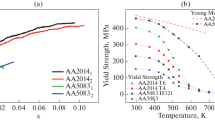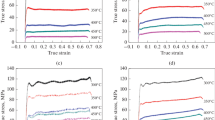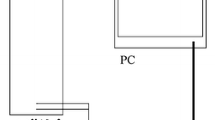Abstract
Precipitation-hardened aluminum alloys gain their high strength through heat treatment involving a severe quenching operation, which can have the adverse effect of introducing residual stresses. The finite element code ABAQUS is used to simulate the quenching of aluminum alloy 7010 in an attempt to predict the residual stress distribution that develops in simple shapes. The rate of heat transfer from the material is determined using the finite element method to predict the heat transfer coefficient from surface cooling curves achieved experimentally. The flow stress of the material is assumed to be strain rate dependent and to behave in a perfectly plastic manner. The predicted residual stress magnitudes and directions are compared to values determined using the holedrilling strain gage method and the X-ray diffraction technique.
Similar content being viewed by others
References
Wallis, R.A., “Modelling Quenching—State of the Art,” Adv. Mat. Processes, 42 (1995).
Jeanmart, P. andBouvaist, J., “Finite Element Calculation and Measurement of Thermal Stresses in Quenched Plates of High Strength 7075 Aluminium Alloy,”Mat. Sci. Tech.,1,765–769 (1985).
Rasty, J., Hashemi, J., Hunter, D.E.,aand Dehghani, M., “Finite Element and Experimental Analysis of Stresses Due to Quenching Process,” ASME Comput. Meth. Mat. Processing,MD-Vol. 39/PED-Vol. 61 (1992).
Yoshihara, N., Tsuyama, S., Hino, Y., and Hirokami, K., “Development of Large High Strength Aluminium Alloy Components for Spacecraft,” NKK Techniqal Review No. 64 (1992).
Becker, R., Karabin, M.E., Liu, J.C., and Smelser, R.E., “Experimental Validation of Predicted Distortion and Residual Stress in Quenched Bars,” ASME Comput. Mat. Modelling,AD-Vol. 42/PVP-Vol. 294 (1994).
Järvsråt, N. and Tjøtta, S., “A Process Model for On-line Quenching of Aluminium Aircraft Components,” Proceedings of the 1st International Non-ferrous Processing and Technology Conference, St. Louis, MO, 249–255 (March 1997).
Labview for Windows Version 3.0.1, “Graphical Programming for Instrumentation,” National Instruments, Austin, TX.
ASTM Standard E837, “Determining Residual Stresses by the Holedrilling Strain-gage Method,” Annual Book of ASTM Standards,3.0.1,American Society for Testing and Materials, Philadelphia (1995).
Measurements Group, “Measurement of Residual Stresses by the Hole Drilling Strain Gage Method,” Technical Note No. TN-503-4.
Lu, J., Handbook of Measurement of Residual Stresses, Society of Experimental Mechanics, 22 (1996).
Robinson, J.S. andFlynn, P., “The Effects of Thermal Treatments on the Stress Corrosion Cracking Resistance of Forgings of the Aluminium Alloy 7010,”Key Eng. Mat.,99–100,143–150 (1995).
“Head Treating of Aluminium Alloys: Volume 4. Heat Treating,” ASM Handbook, 10th ed., ASM International, Metals Park, OH, 841–879 (1995).
Hauk, V., “Non-destructive Methods of Measurement of Residual Stresses,”Advances in Surface Treatments: Residual Stresses,4,A. Nikulari,ed.,Pergamon Press,Oxford, UK (1987).
Prevey, P.S., “X-ray Diffraction Residual Stress Techniques,” Metals Handbook,10,9th ed.,ASM International,Metals Park, OH, 380.
Noyan, I.C. and Cohen, J.B., Residual Stress—Measurement by
Macherauch, E., “X-ray Stress Analysis,” SESA International Conference on Experimental Mechanics, Washington (Oct. 1965).
“ABAQUS Finite Element Code,” Hibbitt, Karlsson & Sorensen, Inc., Pantuck, RI (1998).
Aksel, B., Arthur, W.R., andMukherjee, S., “A Study of Quenching: Experiment and Modelling,”J. Eng. Industry,114,309–316 (1992).
Touloukian, Y.S. andBuyco, H., Specific Heat: Metallic Elements and Alloys, IFI/Plenum Press, New York (1990).
Touloukian, Y.S., Powell, R.W., Ho, C.Y., andKlemens, P.G., “Thermal Conductivity: Metallic Elements and Alloys,”Thermophysical Properties of Matter (Y.S. Touloukian, series editor),IFI/Plenum Press, New York (1970).
Nukiyama, S., “The Maximum and Minimum Values of the Heat Q transmitted from Metal to Boiling Water under Atmospheric Pressure,”J. Jap. Soc. Mech. Engineers,37,367–374 (1934).Translation in Int. J. Heat Mass Trans.,9,1419–1433 (1966).
Boyer, J.C. andBoivin, M., “Numerical Calculations of residual-stress Relaxation in Quenched Plates,”Mat. Sci. Tech.,1,786 (1985).
Dieters, T.A. and Mudawar, I., “Prediction of the Temperature-time Cooling Curves for three-dimensional Aluminum Products during Spray Quenching,” J. heat Treating,8 (1990).
Touloukian, Y.S., Kirby, R.K., Taylor, R.E., andDesai, P.D., “Thermal Expansion: Metallic Elements and Alloys,”Thermophysical Properties of Matter (Y.S. Touloukian, series editor),IFI/Plenum Press, New York (1970).
“Properties of Wrought Aluminum,” Metals Handbook,2,9th ed., ASM International, Metals Park, OH, 130.
Jackson, A., “Homogenisation Effects on the Hot Working of Al−Zn−Mg−Cu Alloys,” Ph.D. diss., University of London (1992).
Sellars, C.M. andTegart, W.J.M., “Hot Workability,”Int. Metallurg. Rev.,17,1–24 (1972).
Hunsicker, H.Y., “Development of Al−Zn−Mg−Cu Alloys for Aircraft,” Rosenhain Centenary Conference (Sept. 1975).
Reynolds, M.A., Fitzsimmons, P.E., and Harris, J.G., “Presentation of Properties of a New High Strength Aluminium Alloy Designated 7010,” Aluminium Alloys in the Aircraft Industry—Symposium, Turin (Oct. 1976).
Fletcher, A.J., Thermal Stress and Strain Generation in Heat Treatment, Elsevier Applied Science, Essex, UK (1989).
Rohsenow, W.M., Harnett, J.P., andGanic, E.N., Handbook of Heat Transfer Fundamentals, 2nd ed., McGraw-Hill, New York, chap. 12 (1985).
Archambault, P., Chevrier, J.C., andBeck, G., “A Contribution to the Optimisation of the 7075 Heat Treatment,”Mat. Sci. Eng.,43,1–6 (1980).
Author information
Authors and Affiliations
Rights and permissions
About this article
Cite this article
Tanner, D.A., Robinson, J.S. Residual stress prediction and determination in 7010 aluminum alloy forgings. Experimental Mechanics 40, 75–82 (2000). https://doi.org/10.1007/BF02327551
Received:
Revised:
Issue Date:
DOI: https://doi.org/10.1007/BF02327551




